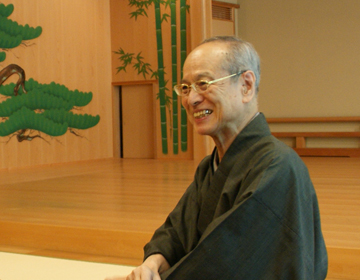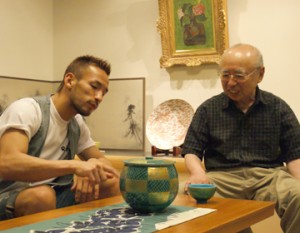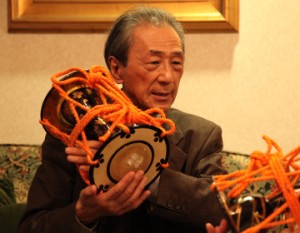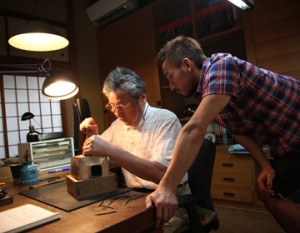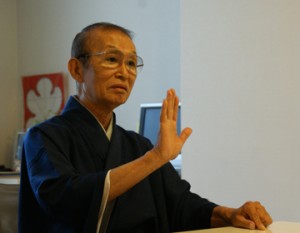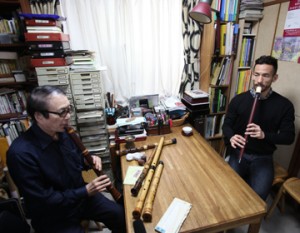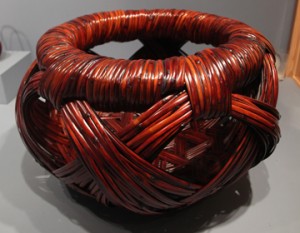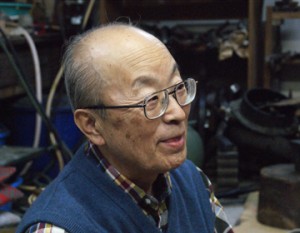Kyogen and Noh Developed Together
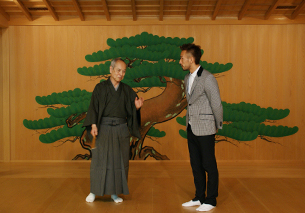
We talked to Mansaku Nomura, Izumi-ryu Kyogen performer. His father is a certified holder of Important Intangible Cultural Asset, Manzo Nomura the 6th. He stood on stage for the very first time when he was 3, and was named the 2nd Mansaku when he was 19. He has undergone strict training, allowing no compromise. In 1990, he was presented with a Medal with Purple Ribbon, and in 2007, he was designated a certified holder of Important Intangible Cultural Asset just like his father. Mansaku Nomura lives in the world of Nohgaku. Nohgaku is a combination of Noh and Kyogen, however during the Edo period, it was referred to as ”Sarugaku”. The audience sits surrounding the protruding stage, and enjoy Noh and Kyogen programs in turn: the subtle and profound style of Noh, and the ”comical” Kyogen. Kyogen is said to ”comically express human nature” and is an art that lays importance on expressing human behavior in an entertaining way with movement and dialogue. ”Noh and Kyogen have to do with opposing themes, but they developed together. There are Kyogen programs that are quite serious,” we were told.
The Souls that were Conveyed in Performances Abroad
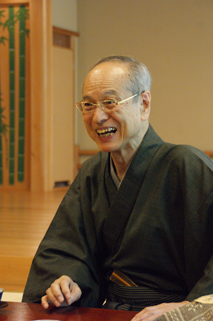
Mansaku told us about an interesting experience he had during a performance in the U.S. The program was ”Tsukimi Zatou”. A blind man encounters a youth, and they enjoy a moment together drinking ”sake” and dancing under the moonlight, seeming to have developed a mutual understanding. However, an instant later, the youth undergoes a complete change and starts to bully the blind man, leaving a bad aftertaste.
”There is a scene where the blind man begs the youth to dance. And he is delighted, though he cannot actually see. There was laughter from the American audience during this scene. Then later, I could sense that the audience was fully captivated during the latter half where the youth transforms and shows an evil side of himself.” ”Why did you choose this program?” Nakata asked.
”Yes, that’s a good question, as I was anxious whether an audience abroad would understand the content of the story. Now, we use English subtitles for the performance, which means that it has to be interpreted in to modern words. Even for the Japanese, it makes it easier to understand, compared to seeing the stage in traditional Japanese. It also makes it easier to perform the more difficult pieces.”
Audiences abroad laugh louder, and truly seem to enjoy the performances.
An Form of Art that Entertains
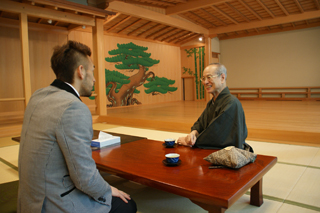
”The Japanese are said to be expressionless and do not laugh out loud very often, even in movie theaters. Kyogen is an art of laughter, but is it appropriate to laugh out loud?” Nakata asked about something that had been bothering him.
”Of course it is. You may be intimidated by the word classical, but of course it is very proper to laugh.” Mansaku Nomura reassured him. ”Just like Noh, we wanted to elevate the artistic position of Kyogen. Our generation has always pursued this theme, and I believe we’ve succeeded to an extent.”
It’s essential to entertain the audience.”
It may not make you laugh out loud, but the nature of Kyogen that developed with Noh is that it brings you. You might say it touches you with happiness.”
Experiencing Kyogen
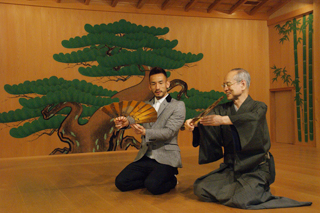
Nakata learns the basic styles from Mansaku Nomura. Nakata’s first impression was the beauty of the posture. He commented, ”I think it would be ideal if you teach this in elementary schools.” ”That is true. The words too. Kyogen could be used to teach correct Japanese,” Mansaku Nomura said.
Mansaku will be working on a new program, ”Shokudoraku”, which is a performance where the eyes, mouth, nose, stomach and heart, all pop out of the body, claiming that they were the reasons that people are able to appreciate food. Obviously it is funny. It is heartwarming and educating, perhaps recommended for children. Kyogen as a traditional art presents infinite possibilities.



